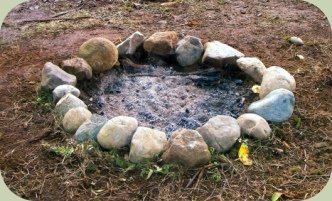Building a Fire Pit

Building a Fire Pit 101
By Jason Knight
Understanding how to build a fire pit with safety and utility in mind is an important wilderness skill. From keeping warm in cold weather to cooking food and providing light, proper fire pit construction is important to make the most of your outdoor experiences. Three important concepts are outlined below: 1. safety considerations, 2. fundamentals of construction, and 3. useful accessories/tips.
1. Safety Considerations When Building a Fire Pit
- Select a flat spot away from trees, shrubs, dry grasses, and anything else that could burn
- Also note any prevailing winds and select a location protected from the wind, to keep coals from being blown out of the fire pit
- Stay clear of overhanging branches and avoid tree roots in the ground that could catch fire
- Clear away any flammable debris (leaves, sticks, pine needles, etc…) for at least ten feet around the fire pit
- Build a fire pit on top of gravel, sand, or bare soil
- Keep a bucket of water or pile of dirt nearby to put out the fire
2. Fundamentals of Fire Pit Construction
- Determine the size of the pit based on your intended uses (Is the primary use creating light, keeping warm, or cooking food? How many people will be utilizing the fire?) A two-foot diameter is often sufficient for one to three people, 3-4 feet for larger groups
- Dig a bowl-shaped depression that is three to eight inches deep at the center (this helps protect and concentrate coals, allowing your fire to burn bright and hot with less smoke)
- Use stones to make a fire ring (this also helps protect and concentrate your fire) Caution: do not use rocks that have been submerged in water, as they can explode when heated. A stone fire pit also retains and radiates heat.
Be More Prepared For Your Next Outdoor Adventure!

Don't leave home without knowing these six essential survival skills. Our free survival mini guide reveals the strategies of:
- Shelter & fire to prevent the number one cause of death
- Obtaining clean water to avoid life-threatening dehydration
- Common wild survival foods and other critical skills!

3. Useful Accessories and Tips
- Incorporate a Heat Reflector: You can utilize a natural feature such as a large rock or embankment as a "heat reflector" to keep heat from escaping your fire pit area and further protect the fire from wind. Heat reflectors can also be created by building a small wall out of stones or logs.
- Designate a cooking area within your fire pit: You can shape your fire ring to have a small bump out for cooking food. Coals can be pulled into this spot to cook over, while your main fire can continue to burn providing light and warmth. Coals cook food far more effectively than flame.
- Drying Wood: Wet wood can be stacked around your fire pit in an "eagle nest" shape. Be sure to monitor wood being dried in this manner so that they do not catch on fire.
- Wood Selection: Small branches from softwoods provide the best kindling for starting a fire, though once your fire is established, seasoned hardwoods will burn hotter and brighter with less smoke. Examples of hardwoods include oaks, maples, and cherries. Also, be sure your wood is dead and dry. Wet or green (live) wood either burns very smoky or often does not burn at all.
Building a fire pit in the wilderness is often a rewarding experience. Now you're ready to enjoy a great night around the campfire!
By the way, if you enjoyed this article then you'll love our survival mini guide. You'll discover six key strategies to staying alive in the outdoors plus often-overlooked survival tips. We're currently giving away free copies here.
Further Resources:

About the Author: Jason Knight is a cofounder of Alderleaf Wilderness College and the author of The Essential Skills of Wilderness Survival. He has been teaching wilderness skills for over twenty-five years. Learn more about Jason Knight.
Return from Building a Fire Pit to Wilderness Skills Articles
Is The Essential Wilderness Survival Skills Course Right for You? Take the "Online Survival Training Readiness" Quiz
See for yourself if this eye-opening course is a good fit for you. It takes just a few minutes! Get your Survival Training Readiness Score Now!

Grow Your Outdoor Skills! Get monthly updates on new wilderness skills, upcoming courses, and special opportunities. Join the free Alderleaf eNews and as a welcome gift you'll get a copy of our Mini Survival Guide.

 The Six Keys to Survival: Get a free copy of our survival mini-guide and monthly tips!
The Six Keys to Survival: Get a free copy of our survival mini-guide and monthly tips!
Learn more